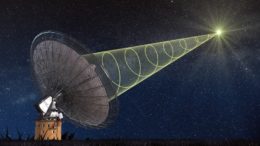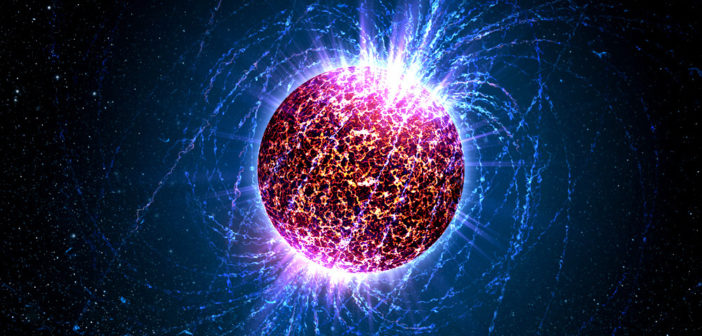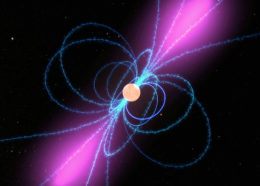Editor’s note: Astrobites is a graduate-student-run organization that digests astrophysical literature for undergraduate students. As part of the partnership between the AAS and astrobites, we occasionally repost astrobites content here at AAS Nova. We hope you enjoy this post from astrobites; the original can be viewed at astrobites.org.
Title: Distinct properties of the radio burst emission from the magnetar XTE J1810−197
Authors: Y. Maan, B.C. Joshi, M. Surnis, M. Bagchi, P. K. Manoharan
First Author’s Institution: ASTRON (Netherlands Institute for Radio Astronomy)
Status: Published in ApJL
Pulsars. Fast Radio Bursts. Magnetars. The world of high-energy stellar astrophysics has no shortage of weird objects that do not always behave like we think they should. From the mysterious workings inside a neutron star to the unknown reason behind why some fast radio bursts repeat, these sources continue to surprise and mystify us. Now, the world of magnetars, stars with incredibly high magnetic fields, just got a little more interesting.
Magnetars: Not Your Average Stellar Objects
Magnetars (short for “magnetic stars”) are neutron stars with some of the strongest magnetic fields in the universe. Their magnetic field strengths are on the order of ~1015 Gauss; to put this in perspective, the magnetic field of the Earth that shields us from the Sun’s rays and produces auroras is about 0.5 Gauss. If a magnetar was at a distance from Earth equal to that of the Moon, it could strip the information off of all of the credit cards on the planet.
In 2006, magnetar XTE J1810-197 (which is also classified as an X-ray pulsar because in addition to having a very strong magnetic field, it intermittently emits X-rays) was found to be emitting radio pulses after a very strong outburst of energy in the radio-frequency regime. At the beginning of this outburst, the pulsar had a nearly flat spectral index. The spectral index tells you how much the total power from the source is dependent on frequency — so if the spectral index was flat, it means that the power emitted was roughly the same at all frequencies. During that burst, radio emission came in spikes that lasted about 10 milliseconds. After the outburst, the source faded in power and essentially turned off before it was re-observed 13 years later and a second radio burst was detected by the authors of today’s work. In Figure 1, you can see how the power emitted by the source declined over time but increased over frequency. Similar “spiky” short-duration radio pulses have been seen in high-energy phenomena such as giant pulses (essentially really bright radio pulses that are occasionally emitted by some sources) and fast radio bursts (FRBs). With these similarities, the bursts from this magnetar could suggest a common origin for these phenomena. Let’s look a bit further into what the authors found from this mysterious source!
Figure 1: The flux density (power) emitted by the source over observing date (top panel) and frequency (bottom panel). It can be seen that as time went on, the power of the star over time but increased over frequency. The top observations were taken between December 8, 2018 to April 27, 2019, and the bottom observations were taken during December 2018. [Maan et al. 2019]
What Are These “Spiky” Bursts?
Magnetar XTE J1810-197 was observed by the team in December of 2018 and February of 2019 with the Giant Metrewave Radio Telescope (GMRT) in India. During that time, they found four spiky bursts. When pulsars are observed, we see what is called an average profile, which maps the energy emitted over the time period that the beam crosses our sightline (the pulse phase window) — and we can make similar diagrams for a magnetar. The first panel in Figure 2 shows the regular pulse profile of the magnetar. In their observations, the authors saw that the position of the bursts roughly match that of the average profile. Unlike in the phenomenon of giant pulses, this emission is not confined to a small area of the pulse phase — which differentiates these spiky magnetar bursts from giant pulses. However, these bursts occur on a much shorter timescale than the regular emission, and they occur with different rates at different frequencies, with a width of 1–4 ms at lower frequencies and < 1 ms at higher frequencies (see second panel of Figure 2). Most of these variations are most likely caused by propagation effects in the interstellar medium.
The spectral index of XTE J1810-197’s bursts also seems to vary quite a bit with frequency. Using models of the electron density of the galaxy, the authors calculate that these variations must be intrinsic to the source and not due to the interstellar medium. The variations are also closer to the onset of the outburst, meaning something happens to the spectral index right before a burst happens. This only happens before bursts in earlier sessions, though, not in later observing sessions.

Figure 2: In the left panel, the black line represents the average profile and the blue dashed line shows the average profile from the first observing session of magnetar XTE J1810-197, with the vertical lines showing the different components. In the right panel, the pulse width distributions over time are shown by frequency (B4: 550−750 MHz and B5: 1260−1460 MHz). It is clear that the 550–750 MHz observations show a higher width which can be attributed to scatter-broadening. [Maan et al. 2019]
So What Does All of This Mean?
When magnetar XTE J1810-197’s first burst was observed in 2003, it was found that the radio spectrum was nearly flat, but after the onset of the current outburst, it was found to be much higher. It is possible that the spectrum is higher at lower frequencies. The power emitted by this object has decreased rapidly since the onset of the burst, but there are no clear physical links between spindown rate (how fast the magnetar slows down because it loses rotational energy) and emitted power.
While the outbursts have similarities to some from known objects, it is not quite clear exactly what they are yet. Giant pulses are characterized by an average energy 10 times greater than the average energy emitted by the source. Though the energies are large in the magnetar bursts, they’re not at the limit of giant pulses. The magnetar bursts are actually more similar to the giant micropulses in the Vela pulsar, as the widths are similar, so it is possible that these could be giant micropulses coming from magnetar XTE J1810-197.

Artist’s impression of a fast radio burst observed by the Parkes Radio Telescope. [Swinburne Astronomy Productions]
The fact that magnetars are the third type of object, after the Crab Pulsar and the repeating FRBs, to exhibit frequency structure in its bursts points to a similar emission mechanism for all three. In addition, the fact that the frequency structure is intrinsic to the star points to some kind of process similar to that of other unexplained high-energy phenomena. What will happen when the star bursts again? Will we find more bursts from other magnetars like this, or repeating FRBs that look similar? Only time will tell!
About the author, Haley Wahl:
I’m a second year grad student at West Virginia University and my main research area is pulsars! I’m currently working with the NANOGrav collaboration (a collaboration which is part of a worldwide effort to detect gravitational waves with pulsars) on polarization calibration. In my set of 45 millisecond pulsars, I’m looking at how the rotation measure (how much the light from the star is rotated by the interstellar medium on its way to us) changes over time, and also looking at other things we can learn from polarimetry. I’m mainly interested in pulsar emission and the weird things we see pulsars do! At WVU, I also work planetarium putting on shows for the public. In addition to doing research, I’m also a huge fan of running, baking, reading, watching movies, and I LOVE dogs!

